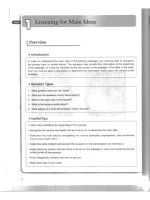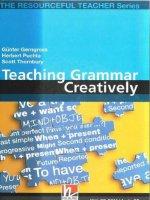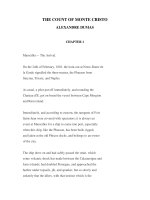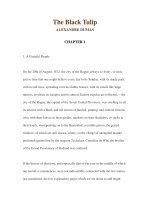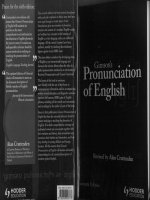Number operation review 1 pps
Bạn đang xem bản rút gọn của tài liệu. Xem và tải ngay bản đầy đủ của tài liệu tại đây (68.6 KB, 6 trang )
͙36
ෆ
ϭ 6 because 6
2
ϭ 36 36 is the square of 6, so 6 is the square root of 36.
Practice Question
Which of the following is equivalent to ͙196
ෆ
?
a. 13
b. 14
c. 15
d. 16
e. 17
Answer
b. ͙196
ෆ
ϭ 14 because 14 ϫ 14 ϭ 196.
Perfect Squares
The square root of a number might not be a whole number. For example, there is not a whole number that can
be multiplied by itself to equal 8. ͙8
ෆ
ϭ 2.8284271
A whole number is a perfect square if its square root is also a whole number:
1 is a perfect square because ͙1
ෆ
ϭ 1
4 is a perfect square because ͙4
ෆ
ϭ 2
9 is a perfect square because ͙9
ෆ
ϭ 3
16 is a perfect square because ͙16
ෆ
ϭ 4
25 is a perfect square because ͙25
ෆ
ϭ 5
36 is a perfect square because ͙36
ෆ
ϭ 6
49 is a perfect square because ͙49
ෆ
ϭ 7
Practice Question
Which of the following is a perfect square?
a. 72
b. 78
c. 80
d. 81
e. 88
Answer
d. Answer choices a, b, c, and e are incorrect because they are not perfect squares. The square root of a
perfect square is a whole number; ͙72
ෆ
≈ 8.485; ͙78
ෆ
≈ 8.832; ͙80
ෆ
≈ 8.944; ͙88
ෆ
≈ 9.381; 81 is a per-
fect square because ͙81
ෆ
ϭ 9.
–NUMBERS AND OPERATIONS REVIEW–
44
Properties of Square Root Radicals
The product of the square roots of two numbers is the same as the square root of their product.
͙a
ෆ
ϫ ͙b
ෆ
ϭ ͙a ϫ b
ෆ
͙7
ෆ
ϫ ͙3
ෆ
ϭ ͙7 ϫ 3
ෆ
ϭ ͙21
ෆ
■
The quotient of the square roots of two numbers is the square root of the quotient of the two numbers.
ϭ
Ί
ᎏ
a
b
ᎏ
,where b ≠ 0 ϭ
Ί
ᎏ
2
8
4
ᎏ
ϭ ͙3
ෆ
■
The square of a square root radical is the radicand.
(͙N
ෆ
)
2
ϭ N (͙4
ෆ
)
2
ϭ ͙4
ෆ
ϫ ͙4
ෆ
ϭ ͙16
ෆ
ϭ 4
■
When adding or subtracting radicals with the same radicand, add or subtract only the coefficients. Keep the
radicand the same.
a͙b
ෆ
ϩ c͙b
ෆ
ϭ (a ϩ c)͙b
ෆ
4͙7
ෆ
ϩ 6͙7
ෆ
ϭ (4 ϩ 6)͙7
ෆ
ϭ 10͙7
ෆ
■
You cannot combine radicals with different radicands using addition or subtraction.
͙a
ෆ
ϩ ͙b
ෆ
≠ ͙a ϩ b
ෆ
͙2
ෆ
ϩ ͙3
ෆ
≠ ͙5
ෆ
■
To simplify a square root radical, write the radicand as the product of two factors, with one number being
the largest perfect square factor. Then write the radical over each factor and simplify.
͙8
ෆ
ϭ ͙4
ෆ
ϫ ͙2
ෆ
ϭ 2 ϫ ͙2
ෆ
ϭ 2͙2
ෆ
͙27
ෆ
ϭ ͙9
ෆ
ϫ ͙3
ෆ
ϭ 3 ϫ ͙3
ෆ
ϭ 3͙3
ෆ
Practice Question
Which of the following is equivalent to 2͙6
ෆ
?
a. 2͙3
ෆ
ϫ ͙3
ෆ
b. ͙24
ෆ
c.
d. 2͙4
ෆ
ϩ 2͙2
ෆ
e. ͙72
ෆ
Answer
b. Answer choice a is incorrect because 2͙3
ෆ
ϫ ͙3
ෆ
ϭ 2͙9
ෆ
. Answer choice c is incorrect because
ϭ 2͙3
ෆ
. Answer choice d is incorrect because you cannot combine radicals with different radi-
cands using addition or subtraction. Answer choice e is incorrect because ͙72
ෆ
ϭ ͙2 ϫ 36
ෆ
ϭ 6͙2
ෆ
.
Answer choice b is correct because ͙24
ෆ
ϭ ͙6 ϫ 4
ෆ
ϭ 2͙6
ෆ
.
2͙9
ෆ
ᎏ
͙3
ෆ
2͙9
ෆ
ᎏ
͙3
ෆ
͙24
ෆ
ᎏ
͙8
ෆ
͙a
ෆ
ᎏ
͙b
ෆ
–NUMBERS AND OPERATIONS REVIEW–
45
Negative Exponents
Negative exponents are the opposite of positive exponents. Therefore, because positive exponents tell you how many
of the base to multiply together, negative exponents tell you how many of the base to divide.
a
Ϫn
ϭ
ᎏ
a
1
n
ᎏ
3
Ϫ2
ϭ
ᎏ
3
1
2
ᎏ
ϭ
ᎏ
3 ϫ
1
3
ᎏ
ϭ
ᎏ
1
9
ᎏ
Ϫ5
Ϫ3
ϭϪ
ᎏ
5
1
3
ᎏ
ϭϪ
ᎏ
5 ϫ
1
5 ϫ 5
ᎏ
ϭϪ
ᎏ
1
1
25
ᎏ
Practice Question
Which of the following is equivalent to Ϫ6
Ϫ4
?
a. Ϫ1,296
b. Ϫ
ᎏ
1,2
6
96
ᎏ
c. Ϫ
ᎏ
1,2
1
96
ᎏ
d.
ᎏ
1,2
1
96
ᎏ
e. 1,296
Answer
c. Ϫ6
Ϫ4
ϭϪ
ᎏ
6
1
4
ᎏ
ϭϪ
ᎏ
6 ϫ 6 ϫ
1
6 ϫ 6
ᎏ
ϭϪ
ᎏ
1,2
1
96
ᎏ
Rational Exponents
Rational numbers are numbers that can be written as fractions (and decimals and repeating decimals). Similarly,
numbers raised to rational exponents are numbers raised to fractional powers:
4
ᎏ
1
2
ᎏ
25
ᎏ
1
2
ᎏ
8
ᎏ
1
3
ᎏ
3
ᎏ
2
3
ᎏ
For a number with a fractional exponent, the numerator of the exponent tells you the power to raise the num-
ber to, and the denominator of the exponent tells you the root you take.
4
ᎏ
1
2
ᎏ
ϭ ͙4
1
ෆ
ϭ ͙4
ෆ
ϭ 2
The numerator is 1, so raise 4 to a power of 1. The denominator is 2, so take the square root.
25
ᎏ
1
2
ᎏ
ϭ ͙25
1
ෆ
ϭ ͙25
ෆ
ϭ 5
The numerator is 1, so raise 25 to a power of 1. The denominator is 2, so take the square root.
8
ᎏ
1
3
ᎏ
ϭ ͙
3
8
1
ෆ
ϭ ͙
3
8
ෆ
ϭ 2
–NUMBERS AND OPERATIONS REVIEW–
46
The numerator is 1, so raise 8 to a power of 1. The denominator is 3, so take the cube root.
3
ᎏ
2
3
ᎏ
ϭ ͙
3
3
2
ෆ
ϭ ͙
3
9
ෆ
The numerator is 2, so raise 3 to a power of 2. The denominator is 3, so take the cube root.
Practice Question
Which of the following is equivalent to 8
ᎏ
2
3
ᎏ
?
a. ͙
3
4
ෆ
b. ͙
3
8
ෆ
c. ͙
3
16
ෆ
d. ͙
3
64
ෆ
e. ͙512
ෆ
Answer
d. In the exponent of 8
ᎏ
2
3
ᎏ
, the numerator is 2, so raise 8 to a power of 2. The denominator is 3, so take the
cube root; ͙
3
8
2
ෆ
ϭ ͙
3
64.
ෆ
Divisibility and Factors
Like multiplication, division can be represented in different ways. In the following examples, 3 is the divisor and
12 is the dividend. The result, 4, is the quotient.
12 Ϭ 3 ϭ 43ͤ12
ෆ
ϭ 4
ᎏ
1
3
2
ᎏ
ϭ 4
Practice Question
In which of the following equations is the divisor 15?
a.
ᎏ
1
5
5
ᎏ
ϭ 3
b.
ᎏ
6
1
0
5
ᎏ
ϭ 4
c. 15 Ϭ 3 ϭ 5
d. 45 Ϭ 3 ϭ 15
e. 10 ͤ15
ෆ
0
ෆ
ϭ 15
Answer
b. The divisor is the number that divides into the dividend to find the quotient. In answer choices a and c,
15 is the dividend. In answer choices d and e, 15 is the quotient. Only in answer choice b is 15 the divisor.
–NUMBERS AND OPERATIONS REVIEW–
47
Odd and Even Numbers
An even number is a number that can be divided by the number 2 to result in a whole number. Even numbers
have a 2, 4, 6, 8, or 0 in the ones place.
2 34 86 1,018 6,987,120
Consecutive even numbers differ by two:
2, 4, 6, 8, 10, 12, 14 . . .
An odd number cannot be divided evenly by the number 2 to result in a whole number. Odd numbers have
a 1, 3, 5, 7, or 9 in the ones place.
1 13 95 2,827 7,820,289
Consecutive odd numbers differ by two:
1, 3, 5, 7, 9, 11, 13 . . .
Even and odd numbers behave consistently when added or multiplied:
even ϩ even ϭ even and even ϫ even ϭ even
odd ϩ odd ϭ even and odd ϫ odd ϭ odd
odd ϩ even ϭ odd and even ϫ odd ϭ even
Practice Question
Which of the following situations must result in an odd number?
a. even number ϩ even number
b. odd number ϫ odd number
c. odd number ϩ 1
d. odd number ϩ odd number
e.
ᎏ
even n
2
umber
ᎏ
Answer
b. a, c, and d definitely yield even numbers; e could yield either an even or an odd number. The product of
two odd numbers (b) is an odd number.
Dividing by Zero
Dividing by zero is impossible. Therefore, the denominator of a fraction can never be zero. Remember this fact
when working with fractions.
Example
ᎏ
n Ϫ
5
4
ᎏ
We know that n ≠ 4 because the denominator cannot be 0.
–NUMBERS AND OPERATIONS REVIEW–
48
Factors
Factors of a number are whole numbers that, when divided into the original number, result in a quotient that is
a whole number.
Example
The factors of 18 are 1, 2, 3, 6, 9, and 18 because these are the only whole numbers that divide evenly into 18.
The common factors of two or more numbers are the factors that the numbers have in common. The great-
est common factor of two or more numbers is the largest of all the common factors. Determining the greatest
common factor is useful for reducing fractions.
Examples
The factors of 28 are 1, 2, 4, 7, 14, and 28.
The factors of 21 are 1, 3, 7, and 21.
The common factors of 28 and 21 are therefore 1 and 7 because they are factors of both 28 and 21.
The greatest common factor of 28 and 21 is therefore 7. It is the largest factor shared by 28 and 21.
Practice Question
What are the common factors of 48 and 36?
a. 1, 2, and 3
b. 1, 2, 3, and 6
c. 1, 2, 3, 6, and 12
d. 1, 2, 3, 6, 8, and 12
e. 1, 2, 3, 4, 6, 8, and 12
Answer
c. The factors of 48 are 1, 2, 3, 6, 8, 12, 24, and 48. The factors of 36 are 1, 2, 3, 6, 12, 18, and 36. Therefore,
their common factors—the factors they share—are 1, 2, 3, 6, and 12.
Multiples
Any number that can be obtained by multiplying a number x by a whole number is called a multiple of x.
Examples
Multiples of x include 1x,2x,3x,4x,5x,6x,7x,8x
Multiples of 5 include 5, 10, 15, 20, 25, 30, 35, 40 . . .
Multiples of 8 include 8, 16, 24, 32, 40, 48, 56, 64 . . .
The common multiples of two or more numbers are the multiples that the numbers have in common. The
least common multiple of two or more numbers is the smallest of all the common multiples. The least common
multiple, or LCM, is used when performing various operations with fractions.
–NUMBERS AND OPERATIONS REVIEW–
49
